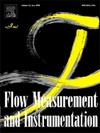基于单点流速测量估算河流流速分布的新方法
IF 2.3
3区 工程技术
Q2 ENGINEERING, MECHANICAL
引用次数: 0
摘要
由于其广泛的实际应用,研究明渠内的流速分布对水利工程和研究都至关重要。基于简化的reynolds -average Navier-Stokes方程,提出了一种改进的二维流速模型,用于明渠流速分布预测和流量估算。采用有限体积法结合非结构三角网格进行数值求解。紊流粘度的计算方法对模型的精度影响很大。在这种情况下,用混合长度理论确定湍流涡流粘度。明渠的涡流粘度是通过测量河流横截面中心点的速度来确定的,然后通过测量速度来计算涡流粘度和整个河道的速度分布。在不同的实验场景下,包括不同的通道截面和粗糙度条件,进行了验证模型。结果表明,该模型能较好地预测流速分布和河流流量。本文章由计算机程序翻译,如有差异,请以英文原文为准。
New method for estimation of velocity distribution in the river based on single point of velocity measurement
Investigating the velocity distribution within open channels is crucial for both hydraulic engineering and research due to its extensive practical uses. This study introduces an improved two-dimensional flow velocity model based on the simplified Reynolds-averaged Navier-Stokes equations for predicting velocity distribution and estimating discharge in open channels. The finite volume method, integrated with an unstructured triangular mesh, is employed for the numerical solution of the equations. The approach to calculating turbulent viscosity significantly affects the model's precision. In this case, the turbulent eddy viscosity is determined using the mixing-length theory. The eddy viscosity in open channels is ascertained by measuring velocity at a central point in the river's cross-section, which then informs the computation of eddy viscosity and velocity distribution throughout the channel. Various experimental scenarios, including different channel cross-sections and roughness conditions, were examined to validate the model. The findings confirm that the model reliably predicts velocity distribution and river discharge.
求助全文
通过发布文献求助,成功后即可免费获取论文全文。
去求助
来源期刊

Flow Measurement and Instrumentation
工程技术-工程:机械
CiteScore
4.30
自引率
13.60%
发文量
123
审稿时长
6 months
期刊介绍:
Flow Measurement and Instrumentation is dedicated to disseminating the latest research results on all aspects of flow measurement, in both closed conduits and open channels. The design of flow measurement systems involves a wide variety of multidisciplinary activities including modelling the flow sensor, the fluid flow and the sensor/fluid interactions through the use of computation techniques; the development of advanced transducer systems and their associated signal processing and the laboratory and field assessment of the overall system under ideal and disturbed conditions.
FMI is the essential forum for critical information exchange, and contributions are particularly encouraged in the following areas of interest:
Modelling: the application of mathematical and computational modelling to the interaction of fluid dynamics with flowmeters, including flowmeter behaviour, improved flowmeter design and installation problems. Application of CAD/CAE techniques to flowmeter modelling are eligible.
Design and development: the detailed design of the flowmeter head and/or signal processing aspects of novel flowmeters. Emphasis is given to papers identifying new sensor configurations, multisensor flow measurement systems, non-intrusive flow metering techniques and the application of microelectronic techniques in smart or intelligent systems.
Calibration techniques: including descriptions of new or existing calibration facilities and techniques, calibration data from different flowmeter types, and calibration intercomparison data from different laboratories.
Installation effect data: dealing with the effects of non-ideal flow conditions on flowmeters. Papers combining a theoretical understanding of flowmeter behaviour with experimental work are particularly welcome.
 求助内容:
求助内容: 应助结果提醒方式:
应助结果提醒方式:


